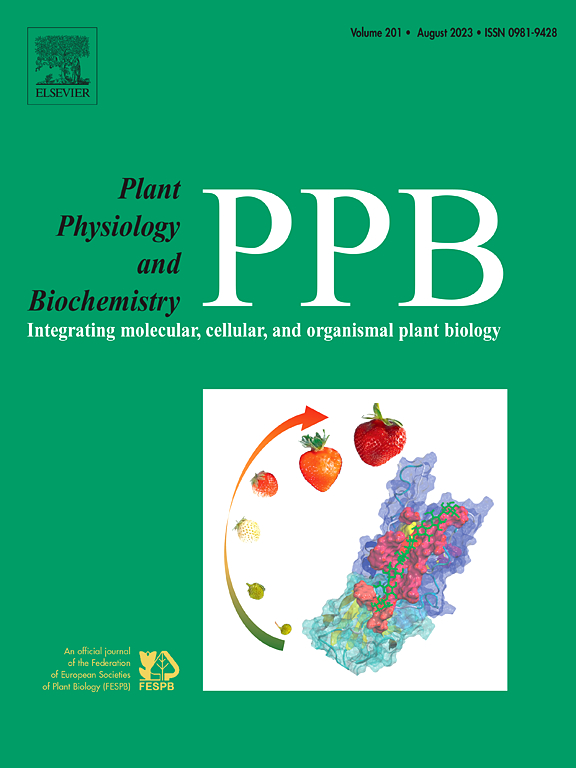对2-呋烷酸处理的不知名Meloidogyne进行转录组学和代谢组学整合,揭示了与运动性和致病性相关的钙调素基因。
IF 6.1
2区 生物学
Q1 PLANT SCIENCES
引用次数: 0
摘要
根结线虫(root-knot nematodes, RKNs)感染严重影响蔬菜生长和作物产量,对全球粮食安全构成严重威胁。我们的前期研究表明,真菌衍生的2-呋喃酸是开发环保型杀线虫剂的先导化合物。然而,确切的分子机制仍然知之甚少。在本研究中,我们观察了100 μg/mL 2-呋喃酸处理后线虫的行为变化。随后,结合转录组学和代谢组学来鉴定差异表达基因(DEGs)和差异表达代谢物(dem)的变化。转录组分析显示有199个基因表达上调,109个基因表达下调。代谢组学分析显示,140种代谢物(72种上调,68种下调)存在显著差异。值得注意的是,整合转录组学和代谢组学分析共鉴定出72个deg和54个dem,它们被标注在51条通路上,包括脂质代谢和氨基酸代谢。有趣的是,51条通路中有14条同时被注释到下调的钙调素基因(cam)上。RNA干扰(RNAi)结果表明,下调的cam是控制RKNs的潜在药物靶点,可显著降低M. incognita的运动性、传染性和致病性。研究结果揭示了2-呋喃酸对黑僵菌的作用机理,为设计环保型杀线虫剂提供了理论依据。本文章由计算机程序翻译,如有差异,请以英文原文为准。

Integration of transcriptomics and metabolomics of 2-furoic acid-treated Meloidogyne incognita reveals a calmodulin gene associated with motility and pathogenicity
Infections caused by root-knot nematodes (RKNs) significantly impair vegetable growth and crop yield, posing a severe threat to global food security. Our previous study indicated that fungal-derived 2-furoic acid was a promising lead compound for the exploitation of eco-friendly nematicides. However, the exact molecular mechanism remains poorly understood. In this study, we observed behavioral changes in the nematodes following treatment with 100 μg/mL of 2-furoic acid. Subsequently, transcriptomics and metabolomics were combined to identify changes in differentially expressed genes (DEGs) and differentially expressed metabolites (DEMs). Transcriptome analysis revealed 199 up-regulated and 109 down-regulated DEGs. Metabolomics analysis indicated that 140 metabolites (72 up-regulated and 68 down-regulated) exhibited significant differences. Notably, the integrated transcriptomics and metabolomics analysis identified a total of 72 DEGs and 54 DEMs annotated across 51 pathways, including lipid metabolism and amino acid metabolism. Intriguingly, 14 out of the 51 pathways were simultaneously annotated to the downregulated calmodulin gene (cam). RNA interference (RNAi) results demonstrated that the down-regulated cam, a potential drug target for controlling RKNs, significantly reduced the motility, infectivity, and pathogenicity of M. incognita. Our results provide insights into the molecular basis of 2-furoic acid against M. incognita and offer a valuable theoretical foundation for the design of eco-friendly nematicides.
求助全文
通过发布文献求助,成功后即可免费获取论文全文。
去求助
来源期刊
CiteScore
11.10
自引率
3.10%
发文量
410
审稿时长
33 days
期刊介绍:
Plant Physiology and Biochemistry publishes original theoretical, experimental and technical contributions in the various fields of plant physiology (biochemistry, physiology, structure, genetics, plant-microbe interactions, etc.) at diverse levels of integration (molecular, subcellular, cellular, organ, whole plant, environmental). Opinions expressed in the journal are the sole responsibility of the authors and publication does not imply the editors'' agreement.
Manuscripts describing molecular-genetic and/or gene expression data that are not integrated with biochemical analysis and/or actual measurements of plant physiological processes are not suitable for PPB. Also "Omics" studies (transcriptomics, proteomics, metabolomics, etc.) reporting descriptive analysis without an element of functional validation assays, will not be considered. Similarly, applied agronomic or phytochemical studies that generate no new, fundamental insights in plant physiological and/or biochemical processes are not suitable for publication in PPB.
Plant Physiology and Biochemistry publishes several types of articles: Reviews, Papers and Short Papers. Articles for Reviews are either invited by the editor or proposed by the authors for the editor''s prior agreement. Reviews should not exceed 40 typewritten pages and Short Papers no more than approximately 8 typewritten pages. The fundamental character of Plant Physiology and Biochemistry remains that of a journal for original results.

 求助内容:
求助内容: 应助结果提醒方式:
应助结果提醒方式:


